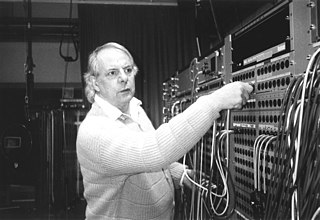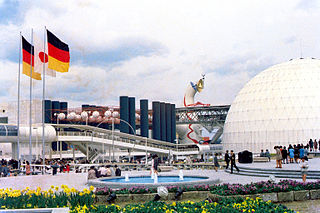
Karlheinz Stockhausen was a German composer, widely acknowledged by critics as one of the most important but also controversial composers of the 20th and early 21st centuries. He is known for his groundbreaking work in electronic music, for introducing controlled chance into serial composition, and for musical spatialization.

Gesang der Jünglinge is an electronic music work by Karlheinz Stockhausen. It was realized in 1955–56 at the Westdeutscher Rundfunk studio in Cologne and is Work Number 8 in the composer's catalog of works. The vocal parts were supplied by 12-year-old Josef Protschka. It is exactly 13 minutes, 14 seconds long.
Electroacoustic music is a genre of Western art music in which composers use technology to manipulate the timbres of acoustic sounds, sometimes by using audio signal processing, such as reverb or harmonizing, on acoustical instruments. It originated around the middle of the 20th century, following the incorporation of electric sound production into compositional practice. The initial developments in electroacoustic music composition to fixed media during the 20th century are associated with the activities of the Groupe de recherches musicales at the ORTF in Paris, the home of musique concrète, the Studio for Electronic Music in Cologne, where the focus was on the composition of elektronische Musik, and the Columbia-Princeton Electronic Music Center in New York City, where tape music, electronic music, and computer music were all explored. Practical electronic music instruments began to appear in the early 20th century.
Karel August Goeyvaerts was a Belgian composer.
David C. Johnson is an American composer, flautist, and performer of live-electronic music.
Gruppen for three orchestras (1955–57) is amongst the best-known compositions of German composer Karlheinz Stockhausen, and is Work Number 6 in the composer's catalog of works. Gruppen is "a landmark in 20th-century music. .. probably the first work of the post-war generation of composers in which technique and imagination combine on the highest level to produce an undisputable masterpiece".
Herbert Eimert was a German music theorist, musicologist, journalist, music critic, editor, radio producer, and composer.
Die Reihe was a German-language music academic journal, edited by Herbert Eimert and Karlheinz Stockhausen and published by Universal Edition (Vienna) between 1955 and 1962. An English edition was published, under the original German title, between 1957 and 1968 by the Theodore Presser Company in association with Universal Edition (London). A related book series titled "Bücher der Reihe" was begun, but only one title ever appeared in it, Herbert Eimert's Grundlagen der musikalischen Reihentechnik.

Kontakte ("Contacts") is an electronic music work by Karlheinz Stockhausen, realized in 1958–60 at the Westdeutscher Rundfunk (WDR) electronic-music studio in Cologne with the assistance of Gottfried Michael Koenig. The score is Nr. 12 in the composer's catalogue of works, and is dedicated to Otto Tomek.

Mikrophonie is the title given by Karlheinz Stockhausen to two of his compositions, written in 1964 and 1965, in which "normally inaudible vibrations ... are made audible by an active process of sound detection ; the microphone is used actively as a musical instrument, in contrast to its former passive function of reproducing sounds as faithfully as possible".

Harald Bode was a German engineer and pioneer in the development of electronic musical instruments.

Hymnen is an electronic and concrete work, with optional live performers, by Karlheinz Stockhausen, composed in 1966–67, and elaborated in 1969. In the composer's catalog of works, it is No. 22.

Zeitmaße is a chamber-music work for five woodwinds composed in 1955–1956 by German composer Karlheinz Stockhausen; it is Number 5 in the composer's catalog. It is the first of three wind quintets written by Stockhausen, followed by Adieu für Wolfgang Sebastian Meyer (1966) and the Rotary Wind Quintet (1997), but is scored with cor anglais instead of the usual French horn of the standard quintet. Its title refers to the different ways that musical time is treated in the composition.
Studie II is an electronic music composition by Karlheinz Stockhausen from the year 1954 and, together with his Studie I, comprises his work number ("opus") 3. It is serially organized on all musical levels and was the first published score of electronic music.
The Konkrete Etüde is the earliest work of electroacoustic tape music by Karlheinz Stockhausen, composed in 1952 and lasting just three-and-a-quarter minutes. The composer retrospectively gave it the number "1⁄5" in his catalogue of works.
Nummer 5 met zuivere tonen is a musical work by the Belgian composer Karel Goeyvaerts, realized at the WDR Studio for Electronic Music in 1953 and one of the earliest pieces of electronic music.

Stop is a composition for orchestra by Karlheinz Stockhausen, work-number 18 in the composer’s catalogue of works, where two performing realisations are also found as Nr. 18½ and Nr. 18⅔.
Unsichtbare Chöre is an eight-channel electronic-music composition by Karlheinz Stockhausen. A component part of the opera Donnerstag aus Licht, it may also be performed as an independent composition, in which form it is designated "ex 49" in the composer's catalog of works.

Expo, for three performers with shortwave radio receivers and a sound projectionist, is a composition by Karlheinz Stockhausen, written in 1969–70. It is Number 31 in the catalogue of the composer's works.

The Studio for Electronic Music of the West German Radio was a facility of the Westdeutscher Rundfunk (WDR) in Cologne. It was the first of its kind in the world, and its history reflects the development of electronic music in the second half of the twentieth century.










